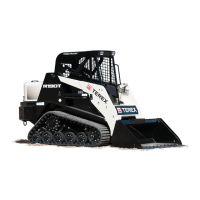2.17 Transporting the Machine
• Use only suitable transport and lifting equipment with sufficient carrying
capacity.
• Load the machine on firm and level ground.
• Before driving onto the ramps, clean them and the machine tracks of any
materials that may cause slippage (snow, ice, water, mud, sludge, oil, etc.).
• Properly align the machine with the loading ramp.
• Have a guide give the machine operator any necessary signs to maximize
safety during loading.
• Back the machine carefully up the ramps and onto the transport vehicle.
Note: The heaviest end of the machine should remain uphill when operating on
an incline. Always back the machine onto the transport vehicle unless fitted with a
heavy attachment or loaded bucket.
• Before you leave the machine, relieve all residual pressure by making sure
all operating levers and switches are in their neutral positions. Remove the
ignition key.
• Secure the door, windows and hood on the machine.
• Secure the machine and any other items against slipping with chains, ropes
of the proper capacity.
• Before departure, investigate the route to be taken, especially in regard to
limits for width, height and weight.
• Pay close attention when driving under electrical lines, bridges, or through
tunnels.
• Use the same caution when unloading as for loading. Remove all
cables/chains. Start the engine as described in the operating instructions.
Carefully drive down the ramp from the transport vehicle using a guide if
necessary to direct movement.
• When lifting attachments or components, use caution. Attach straps or
chains securely and in such a way that they evenly distribute the weight of
the item to be lifted, ensuring a balanced load. Stay clear of expected travel
path.
2 SAFETY
23
RT-60/R160T/R190T ROW O&M
0404-659 2016-05

